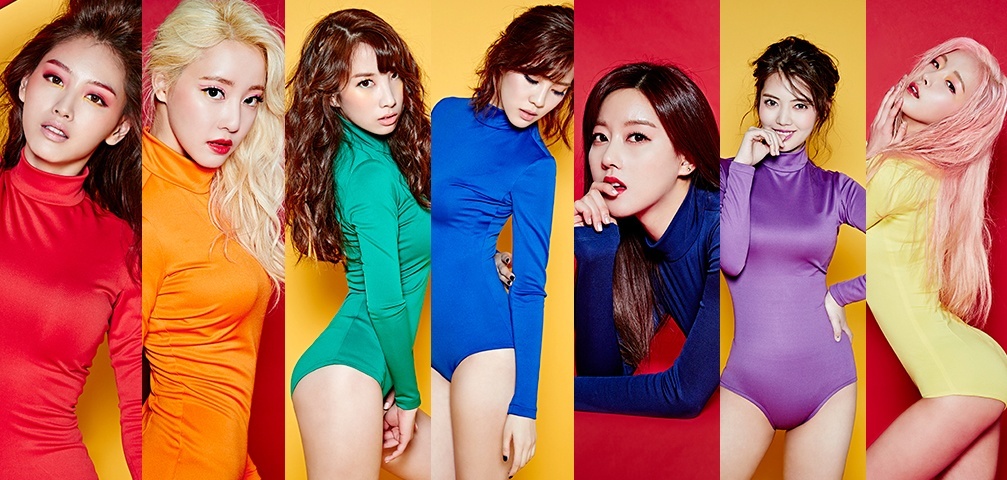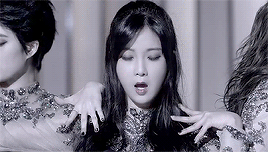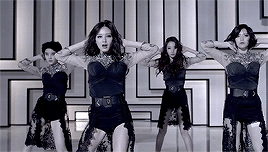What do you find at the end of a Rainbow?

The inevitability of my favourite K-pop groups coming to an end is something I’m used to now. The demise is nearly always slow with groups who were once household names dropping lower in the charts with every new release. So when DSP recently announced that Rainbow would be disbanding, I was not surprised nor was I heartbroken. Yet, when I thought about it, there was no group who deserved this less than Rainbow. Throughout their career, only one major single stands out as bad, their debut “Gossip Girl,” and their albums are littered with overlooked gems. They brought a spectrum of sounds and looks delivered with a consistent quality that few can match.
Rainbow debuted with a killer concept. Each member being one colour of the spectrum was so clever but simple to pull off. All of them would be easily identifiable by what they wore, a key point for a new group. The problem with it though is that DSP probably had the idea and tried to rush out the group to attach to it, meaning that some members may just be there because they needed seven girls. The lack of memorable characters in the group may be a big factor in their downfall. Today, more than ever groups need big characters, look at Twice and I.O.I for example. A terrible debut song doesn’t help either.
Also on KultScene: 8 K-pop girl power anthems pt. 7
Rainbow’s work with some K-pop’s best producers allowed them to recover from that dreadful critical and commercial debut. Following a similar formula two years in a row, Rainbow released two singles by the same producer in 2010 and 2011. Their first two were with Sweetune, staying loyal to DSP after making their name with KARA. Even though by today’s standards “A” and “Mach” could sound a little cheaper than we expect from Sweetune, they still remain some of their best work.
“A” is Rainbow’s most iconic track. K-pop was beginning to show signs of embracing sexiness at this time, but nobody confronted it quite like Rainbow and “A.” The shirt lifting choreography makes being sexy something more than just a concept or dance. The members are active in showing their bodies; it brings an agency that is so often absent. Making them complicit is a bold choice, but one that is pulled off thanks to the confidence of a young group. It actually threatened to overshadow the song as well, which would be the greatest shame of Rainbow’s career. Sweetune switch out their usual synths for horns and guitars, which drive the song with bombastic energy. It has a relentless, kinetic force that builds and peaks at the two minute mark with the second chorus (which is itself essentially two choruses).
If “A” didn’t overshadow itself, it probably did leave their second single with Sweetune, “Mach,” with little to show. Without the choreography gimmick, it could not take off, so it charted lower than “A” despite being just as good. Horns again take the front seat, but this time along with prominent synths made to sound like horns. It’s similar to “A,” but heavier and more dramatic. A cacophonous soundscape that grabs you by the throat.
In 2011, Rainbow moved onto a producer that K-pop sorely misses. Japanese DJ Daishi Dance specializes in mixing pianos and electronics, focusing on dance tracks in which you don’t know whether to shake your body or dry your eyes. He also produced After School’s gorgeous “Shampoo” in the same year. With “To Me” and “Sweet Dream,” he created Rainbow’s highest charting singles and their best era.
Like “A” and “Mach,” they are of a similar style and structure but with different tones. Both use crystal clear pianos set against a dance beat. “To Me” is the more upbeat of the two, with its addictive hook of “oh eh oh ehs,” contrasting well with leader Jaekyung’s (an idol of considerable talent and beauty that deserves a solo career after this) belts in the chorus. Daishi Dance’s distinct sound really helped Rainbow stand out, the mix of pianos and synths is evocative in strange ways we can relate with.
“Sweet Dream” is the culmination of these ideas. More subdued than “To Me,” it uses the sentimental sounds to the best of their expression. “Sweet Dream” is about a girl who knows she is about to be broken up with and does not want to believe it. “Don’t wake me up from this sweet dream,” they cry. The music video setting of a club brings it altogether. This is still a dance song, so of course they could perform it in a club. Yet it’s clearly a song of great pain too, brought to life best by the voice of maknae Hyunyoung. The girls walk around the club, their bodies splitting into many parts. Their minds reeling from the potential break up that they can’t think straight. They are highlighted by slow motion, even amongst such a setting they still can’t escape their emotions. The contradiction of the song is brought into great clarity by the video.
Also on KultScene: Op-ed: Trump, BTS, & the state of K-pop journalism
After these stellar two years, Rainbow’s success began to drop. Maybe it was the two years it took them to release something after “Sweet Dream,” but it’s hard to see why they really failed. There was certainly no drop in quality as all of their songs from “Tell Me Tell Me” up to their last single “Whoo” were either good or great. Even more impressive is that all of the rest of their albums were pretty much perfect start to finish. Again, their continued work with top producers keeps getting them great tracks.
On “Rainbow Syndrome Part 1,” producers Zig Zag Note gave them the brash “Cosmic Girl.” It pairs interstellar lyrics and synthesizers with old fashioned pop sounds. The string and horn sections are what make the song feel cosmic, the intro especially feels like the beginning of something huge.
Rainbow, however, are not always all about the big energy. Neither are Zig Zag Note, apparently, as they provided Rainbow with “EENIE MEENIE MINIE MOE,” a stripped back oddity on “Rainbow Syndrome Part 2.” It begins with just a piano, flat toms, and the vocals. It’s delivered with a cheeky confidence that is so infectious but never irritating. Singing the title towards the end like a nursery rhyme is particularly addictive.
Following “Rainbow Syndrome,” Rainbow moved on to the era where we could see their end in sight. First their sexy and subversive sub-unit Rainbow Blaxx, with heavyweights Digipedi behind the incisive video for “Cha Cha.” “Black Swan” and the “Innocent” album followed and were commercial disasters. It was a change in style too far for Korea. Which is a shame, since the album is so good that I can’t pick a favourite. “Pierrot” did dancehall better than any other Korean act and used No Eul well for the first time ever. “Bad Man Crying” is a perfectly balanced outpouring of emotion; Hyunyoung’s voice cuts through it beautifully. The soulful “Mr. Lee,” funky “Privacy,” and sombre “A Little More” round out what is one of the best K-pop mini albums of all time.
Their final album, “Prism,” while not as good as “Innocent” is still great by most K-pop mini-album standards. More great producers turn up as well. Sweetune returned to say goodbye to Rainbow with their spinoff team Monotree on sweet opener “Saying I Miss You”. e.one, meanwhile, produced stomper “Click!” By then, it was too late though; the public had moved on from Rainbow.
So what do we find at the end of the rainbow? Namely a sad end to a great underappreciated career. The future careers of the members are not easy either. Few of them made names for themselves outside of the group. Only Jisook and Jaekyung seem safe in the entertainment business anyway. Also, DSP are in a bad situation themselves. Their remaining groups are either flopping (April) or just not working (A-Jax). Without their original powerhouses, they need to act fast. There is no pot of gold here, unfortunately.
Now that we have reached the end though, we know for sure that the treasure is not gold but the rainbow itself. With hindsight, we can look back at Rainbow’s glistening beauty and talent and remember one of the great girl groups of our time. Take your time appreciating the entire spectrum of their career; there is much more than just colour to find.
What’s your favourite Rainbow song or performance? Share your picks and thoughts in the comment section below and be sure to subscribe to the site and follow us on Facebook, Twitter, Instagram, and Tumblr to keep up with all of our posts.


